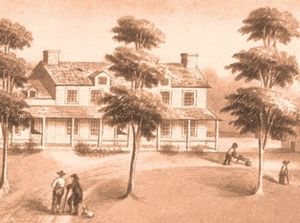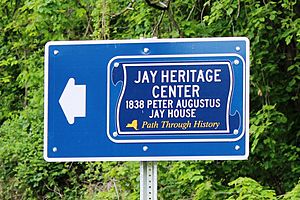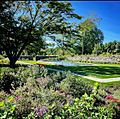Jay Estate facts for kids
|
The Jay Estate
|
|
|
U.S. Historic district
Contributing property |
|
|
U.S. National Historic Landmark District
Contributing Property |
|
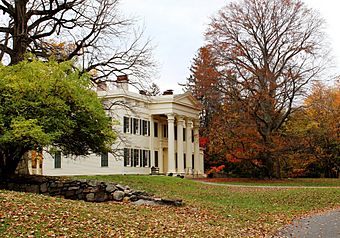
The Jay Estate in Rye, NY
|
|
| Location | 210 Boston Post Road, Rye, New York |
|---|---|
| Area | 23 acres with 3 owners: NY State Parks, Westchester County Parks and the Jay Heritage Center |
| Built | 1745; 1838; 1907 |
| Built by | Edwin Bishop with influences by Minard Lafever, Asher Benjamin and Chester Hills; Frank A. Rooke |
| Architectural style | Greek Revival; Classical Revival |
| Restored by | Jay Heritage Center |
| Website | www.jayheritagecenter.org |
| Part of | Boston Post Road Historic District (Rye, New York) (ID82001275) |
Quick facts for kids Significant dates |
|
| Added to NRHP | October 29, 1982 |
| Designated NHLDCP | August 30, 1993 |
The Jay Estate is a 23-acre park and historic site in Rye. At its heart is the 1838 Peter Augustus Jay House. This special place is a key part of the Boston Post Road Historic District. This district became a National Historic Landmark District in 1993.
This site is what remains of a 400-acre farm. Here, John Jay, one of the US Founding Fathers, grew up. He was born in 1745 and passed away in 1829. John Jay returned here to celebrate the end of the Revolutionary War. He had helped negotiate the 1783 Treaty of Paris with John Adams and Benjamin Franklin.
The Jay Estate is on the south side of the Boston Post Road (US 1). It offers a great view of Milton Harbor. This historic site is also part of a very old Paleo-Indian archaeological site. It overlooks New York State's oldest managed meadow. The Jay Estate is also an important stop on the African American Heritage Trail. It is one of a few national landmarks dedicated to teaching about the Founding Fathers. Other examples include Mount Vernon (Washington's home) and Monticello (Jefferson's home).
Contents
- Who Owns and Cares for the Jay Estate?
- The History of the Jay Estate
- How Old is the Jay Estate Site?
- John Jay's Childhood Home
- The Jay Family Home Through the Years
- The 1838 Jay Mansion
- Alansten: A New Name for the Estate
- 20th Century Owners of the Jay Estate
- Saving the Jay Estate from Development
- African American Heritage Trail Site
- Recognized for History and Green Practices
- NY Path Through History
- Plants and Animals at the Jay Estate
- Images for kids
Who Owns and Cares for the Jay Estate?
The Jay Estate has three different owners. These are New York State Parks, Westchester County, and the Jay Heritage Center. New York State Parks owns 90% of a 21.5-acre area. Westchester County owns the other 10% of this land.
The non-profit Jay Heritage Center (JHC) owns 1.5 acres. This includes the Jay Mansion and the 1907 Van Norden Carriage House. Since 2013, the JHC has been in charge of caring for the State and County's 21.5 acres. This includes preserving, restoring, and explaining the site. The JHC raises all its money through donations and grants. They do not get funds from New York State or Westchester County. All preservation work follows strict rules from the Department of the Interior.
The Jay Estate is next to the Marshlands Conservancy. This is a separate nature preserve. Westchester County Parks owns and runs it.
The History of the Jay Estate
How Old is the Jay Estate Site?
The Jay Estate is part of the Boston Post Road Historic District. This area is very important for archaeology. Evidence shows people lived here thousands of years ago. There are signs of Middle Woodland, Late Woodland, and Late Archaic periods. These go back as far as 3000-4999 BC. Later historical periods are also found here.
John Jay's Childhood Home
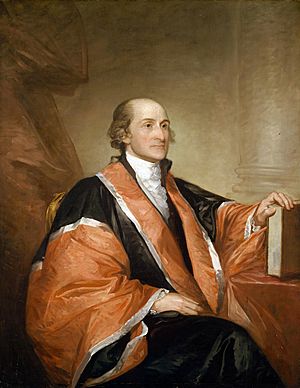
John Jay was one of America's seven most famous Founding Fathers. He was the only one born in what is now New York State. He grew up in Rye from when he was three months old. He called his home the "Family Seat." It was a 400-acre farm later named "The Locusts." It overlooked Long Island Sound. John Jay's father, Peter, first leased and then bought the property.
John Jay's mother, Mary, taught him at home until he was eight. Three of his siblings had disabilities. Augustus had learning disabilities, and Anna and Peter were blind. Two other siblings, Eve and Frederick, also lived there. In 1755, a New York State Census showed eight enslaved people lived on the estate. In 2017, parts of what looked like an enslaved person's home were found. Old drawings show many small buildings around the main house. These included an ice house, stable, and smokehouse. A farmhouse from the 1760s still stands today. The property had many wells and two streams for water. They grew crops like potatoes.
At 14, John Jay went to New York City to study law. He still came home every two weeks for family time and holidays. Letters from his father mention the names of enslaved people living there. These included Moll, Old Plato, Little Plat, Old Mary, Young Mary, Zilpha, Clarinda, and Anthony.
The Jay Family Home Through the Years
In 1765, the Stamp Act caused many lawyers, including Jay, to go on strike. He returned home from 1765 to 1766. He spent this time re-reading classic books. After negotiating the Treaty of Paris, which ended the Revolutionary War, Jay celebrated at his Rye home in July 1784.
While Governor of New York, John Jay noted his ownership of 70 acres in Rye. This land was next to his brother Peter Jay's farm. John Jay and his family, including his wife Sarah Livingston Jay and son William Jay (jurist), spent time there. After retiring to Bedford, John Jay inherited his brother's part of the estate. He managed the property from 1813 to 1822. Then, he gave it to his oldest son, Peter Augustus, in 1822. He still gave advice on planting many trees.
During this time, the landscape changed. Stone walls called ha-has replaced fences. The view of Long Island Sound was shaped more formally. Three large elm trees were planted behind the main house. They replaced three locust trees that fell in a storm in 1822. The last enslaved person on the property, Caesar Valentine, was freed in 1824. He stayed with the Jay family until he died and was buried on the farm in 1847.
Famous visitors to the Jay Estate during this period included Yale President Timothy Dwight IV. The American novelist James Fenimore Cooper also visited. So did the artist and inventor Samuel F. B. Morse.
The 1838 Jay Mansion
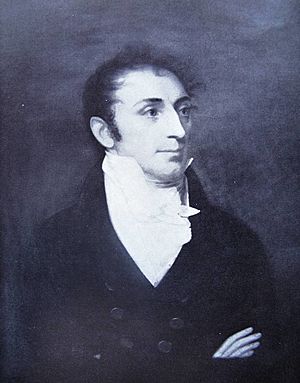
Seven years after his father's death, Peter Augustus Jay built a new house in 1838. He sadly took down the old family home. But he used its wood, doors, shutters, and nails in the new building. The new house was built on the same spot as the first one. The mansion's design was likely influenced by architectural books. These were by Minard Lafever, Asher Benjamin, and Chester Hills. The front of the mansion looks grand. But the back porch is simple and has the same size as the first house's porch. It is one story high and 80 feet long.
Alansten: A New Name for the Estate
After Peter Augustus Jay died in 1843, his son John Clarkson Jay inherited the Jay Estate. Dr. Jay was a famous shell collector and a doctor. He also helped start the New York Yacht Club. He made changes to the mansion, like moving the main staircase. In 1849, he added a Carpenter Gothic cottage. This cottage was based on designs by Alexander Jackson Davis. He also added a bowling alley. Dr. Jay gave the property a new name: "Alansten."
Parts of the property were leased to gardeners and farmers. They managed the land as a dairy farm for the Jay family. The land was kept open for animals and planted with crops like rye, wheat, and corn. The home stayed in the Jay family until 1904. Other important owners and residents during this time included landscape architect Mary Rutherfurd Jay. Her brother Pierre Jay was the first Chairman of the Federal Reserve Bank of New York. Art collector and giver Junius Spencer Morgan II also lived there.
20th Century Owners of the Jay Estate
In the 20th century, several people owned the Jay Estate. Architect Henry Ives Cobb bought the land in 1904. He hoped to build on it. Dutch financier Warner M. Van Norden and Grace Talcott owned it from 1905 to 1911. They kept rare animals like Highland cattle and Grevy zebras. Princeton supporter Edgar Palmer and his wife Zilph owned it from 1911 to 1935. Walter B. Devereux, President of the National Horse Show, and his wife Zilph owned it from 1935 to 1966. The Methodist Church owned it from 1966 to 1979. Finally, a real estate company called DGM Partners owned it from 1979 to 1992.
Around 1917, a large Indoor Tennis House was built. Landscape architects Brinley & Holbrook redesigned the gardens.
Saving the Jay Estate from Development
In 1979, the Jay Estate was in danger of being developed. Many groups worked together to save it. More than 62 historical and environmental organizations formed the "Jay Coalition." This group later became the Jay Heritage Center. Many government officials also helped. Supreme Court Justice Harry A. Blackmun visited the site during this time.
Justice Blackmun saw the preserved land and views from John Jay's youth. He said the place was a symbol of the late 1700s. He felt it showed gracious living and importance. But it also showed a sense of duty, especially to government and getting along with others.
During this time, the surrounding Boston Post Road Historic District was added to the National Historic Register of Places in 1982. In 1992, after 13 years of talks, Westchester County bought the 23-acre property for $11.5 million. This saved the Jay Estate. Two buildings and 1.5 acres in the middle of the property were sold to the Jay Heritage Center.
African American Heritage Trail Site
The Jay Estate was home to many enslaved and freed people from the Jay family. Some were also buried here. Because of this, the estate was named one of 13 sites on the African American Heritage Trail of Westchester County in 2004.
John Jay had a complex history. He owned enslaved people but also worked to end slavery. He was the first President of the New-York Manumission Society. He also helped start the first African Free School. His son, Peter Augustus Jay, continued his father's work. He also served as President of the Manumission Society.
Recognized for History and Green Practices
In November 2008, the Peter Augustus Jay House became the oldest National Historic Landmark in New York State. It was updated with an energy-efficient geothermal heating and cooling system.
In January 2009, the 23-acre Jay Estate became a member site of the Hudson River Valley National Heritage Area (HRVNHA). This was because of its important architecture and history. It was also recognized for its green management and sustainability efforts. The National Park Service (NPS) gives this special designation.
The Jay mansion is known as a very pure example of Greek Revival architecture. Architectural historian Andrew Dolkart called the 1838 Peter Jay House a "major architectural landmark." He said it is one of the most important buildings of its kind in the country. Its grand style shows the growing wealth and power of America in the 1830s. It also shows how important the Jay family was to the young nation.
NY Path Through History
In 2013, the Jay Estate was added to New York State's Path Through History. It is an important site for learning about Civil Rights.
Plants and Animals at the Jay Estate
Native plants and trees at the Jay Estate include elms, oaks, and red maples. The park is also home to many wild turkeys, red-tailed hawks, and coyotes.
Some invasive plant species have been found at the Jay Estate. These include mugwort, multiflora rose, Norway maples, and Japanese knotweed. These plants are tracked using the iNaturalist app.
Images for kids


